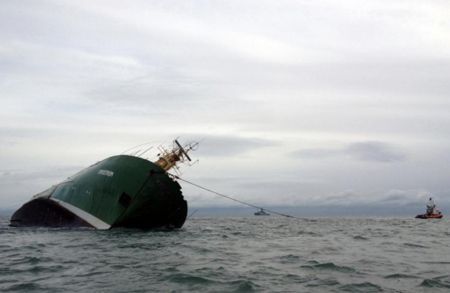
Crews from two Royal Navy ships helped prevent a tug from sinking on the evening of January 13 in a dramatic rescue off the Devon coast. Sailors from HMS Lancaster and HMS Severn struggled in dark, freezing conditions to plug a hole in the damaged hull of the Christos XXII and pumped out tons of water to prevent it sinking into the Channel.
They fought against the fast-moving leak by hammering wooden wedges into a foot-long gap caused when the vessel the tug was towing crashed into it shortly after 9pm at Hope’s Nose near Torbay.
The temporary repairs made by the sailors managed to stem the tide, while diesel pumps from HMS Severn pumped out over 70 tons of water an hour in a bid to stop the Christos XXII from sinking.
The tug had been towing an 80m (262ft) boat, the Emstrom, from Germany to Turkey when the accident occurred.
The RNLI’s Exmouth and Torbay lifeboats responded to the SOS and rescued most of the tug’s crew. But their pumps were unable to stem the tide and the Christos XXII was in danger of foundering.
The coastguard then called in fishery protection ship HMS Severn and Type-23 frigate HMS Lancaster, which was sailing from her home base of Portsmouth to Plymouth.
Both warships sent sailors across in their sea boats, with one team boarding the tug to pump water and the other tasked with finding the gash in the Christos XXII.
“It was very cold, there was very little light and they were going into an unfamiliar space,” said Commander Steve Moorhouse, HMS Lancaster’s Commanding Officer.
“It was quite a demanding job for everyone.
“They found a reasonably-sized gash in the engine room and hammered soft wood into it. The water was cold, waist deep and at times the sailors had to duck their heads under to get the wedges in.”
While they were struggling against the Channel, Severn’s diesel pumps were in action. Due to the fumes in the enclosed room and the temperature of the water – hands became numb with cold and unable to grasp the hammers – the sailors were rotated over the six or seven-hour rescue mission, with hot food was sent across to keep up their energy levels.
“The team came back very cold and tired but high on adrenaline and big smiles on their faces at a job well done,” said Cdr Moorhouse.
“There’s no doubt in my mind that the tug would have founded without the Royal Navy’ efforts.
“Our training really made a difference. Working in the flooded engine room was just like being in a replica of our damage trainer which trains our sailors in flood damage control.
“You hear a lot of mayday calls off the South Coat and more often than not they don’t turn into anything.
“We quickly realised this was the real thing. We helped as any mariner in the world would do in the same circumstances.”
By daybreak a salvage tug was on the scene with specialist divers ready to patch up the damaged tug, while another vessel had taken the Emstrom in tow.
We use cookies to improve your experience. By continuing to use our site, you accept our Cookies, Privacy Policy,Terms and Conditions. Close X